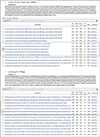1. Pendle S, Weeks K, Priest M, Gill A, Hudson B, Kotsiou G, et al. Phaeohyphomycotic soft tissue infections caused by the coelomycetous fungus Microsphaeropsis arundinis. J Clin Microbiol. 2004; 42:5315–5319.

2. Asahina A, Kobayashi M, Nakano K, Saito I, Yarita K, Kamei K, et al. Deep cutaneous infection with Microsphaeropsis arundinis: report of two Japanese cases. Acta Derm Venereol. 2015; 95:855–857.

3. Hall MR, Brumble LM, Mayes MA, Snow JL, Keeling JH. Cutaneous Microsphaeropsis arundinis infection initially interpreted as squamous cell carcinoma. Int J Dermatol. 2013; 52:84–86.

4. Kim MN, Shin JH, Sung H, Lee K, Kim EC, Ryoo N, et al. Candida haemulonii and closely related species at 5 university hospitals in Korea: identification, antifungal susceptibility, and clinical features. Clin Infect Dis. 2009; 48:e57–e61.
5. Crawford SJ, Chen SC, Halliday C, Rangan GK, Gottlieb T, Reid AB. Microsphaeropsis arundinis skin and soft tissue infection in renal transplant recipients: three case reports and a review of the literature. Transpl Infect Dis. 2015; 17:915–920.

6. Lee KC, Kim MJ, Chae SY, Lee HS, Jang YH, Lee SJ, et al. A case of phaeohyphomycosis caused by Exophiala lecaniicorni. Ann Dermatol. 2016; 28:385–387.

7. Ryu TH, Kwon IH, Choi JE, Ahn HH, Kye YC, Seo SH. A case of subcutaneous phaeohyphomycosis caused by Exophiala oligosperma showing multiple cysts. Korean J Dermatol. 2017; 55:259–263.
8. Suh MK, Kwon SW, Kim TH, Sun YW, Lim JW, Ha GY, et al. A case of subcutaneous phaeohyphomycosis caused by Exophiala jeanselmei. Korean J Dermatol. 2005; 43:124–127.
9. Ajello L, Georg LK, Steigbigel RT, Wang CJ. A case of phaeohyphomycosis caused by a new species of Phialophora. Mycologia. 1974; 66:490–498.

10. Sutton DA. Coelomycetous fungi in human disease. A review: clinical entities, pathogenesis, identification and therapy. Rev Iberoam Micol. 1999; 16:171–179.
11. Stchigel AM, Sutton DA. Coelomycete fungi in the clinical lab. Curr Fungal Infect Rep. 2013; 7:171–191.

12. Chowdhary A, Meis JF, Guarro J, de Hoog GS, Kathuria S, Arendrup MC, et al. ESCMID and ECMM joint clinical guidelines for the diagnosis and management of systemic phaeohyphomycosis: diseases caused by black fungi. Clin Microbiol Infect. 2014; 20 Suppl 3:47–75.

13. Ostrosky-Zeichner L, Alexander BD, Kett DH, Vazquez J, Pappas PG, Saeki F, et al. Multicenter clinical evaluation of the (1--〉3) beta-D-glucan assay as an aid to diagnosis of fungal infections in humans. Clin Infect Dis. 2005; 41:654–659.

14. Perusquía-Ortiz AM, Vázquez-González D, Bonifaz A. Opportunistic filamentous mycoses: aspergillosis, mucormycosis, phaeohyphomycosis and hyalohyphomycosis. J Dtsch Dermatol Ges. 2012; 10:611–621. quiz 621-622.









 PDF
PDF Citation
Citation Print
Print



 XML Download
XML Download